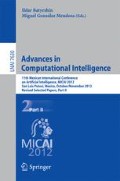Abstract
In this paper a new strategy for analyzing the capability of flow conductivity of hydrocarbon in fractures associated to a reservoir under study is presented. This strategy is described as an integrated methodology which involves as input data the intersection points of fractures that are extracted from hand-sample fracture images obtained from cores in a Naturally Fractured Reservoir. This methodology consists of two main stages. The first stage carries out the analysis and image processing, whose goal is the extraction of the topological structure from the system. The second stage is focused on finding the node or vertex, which represents the most important node of the graph applying an improved betweenness centrality measure. Once the representative node is obtained, the intensity of intersection points of the fractures is quantified. In this stage a sand box technique based on different radius for obtaining an intensity pattern in the reservoir is used. The results obtained from the integrated strategy allow us to deduce in the characterization of reservoir, by knowing the possible flow conductivity in the topology of the fractures viewed as complex network. Moreover our results may be also of interest in the formulation of models in the whole characterization of the reservoir.
Access this chapter
Tax calculation will be finalised at checkout
Purchases are for personal use only
Preview
Unable to display preview. Download preview PDF.
References
Aguilera, R.: Naturally Fractured Reservoirs, 2nd edn. PennWel Books (1995)
Nelson, R.A.: Geological Analysis of Naturally Fractured Reservoir. Gulf Publ. (2001)
Narr, W., Schechter, D.S., Thompson, L.B.: Naturally Fractured Reservoir Characterization. Society of Petroleum Engineers, Richardson, Texas (2006)
Baker, R.O., Kuppe, F.: Reservoir Characterization for Naturally Fractured Reservoirs. Paper SPE 63286, SPE Annual Technical Conference and Exhibition, Dallas, Texas, October 1-4 (2000)
Gauthier, B.D.M., Garcia, M., Daniel, J.-M.: Integrated Fractured Reservoir Characterization: A Case Study in a North Africa Field. SPEREE 5(4), 284–294 (2002), SPE-79105-PA
Bogatkov, D., Babadagli, T.: Characterization of Fracture Network System of the Midale Field. Paper 2007-031, CIM 58th Annual Tech. Meet., Canadian International Petroleum Conf., Calgary, Canada, June 12-14 (2007)
Guerreiro, L., Silva, A.C., Alcobia, V., Soares, A.: Integrated Reservoir Charac-terisation of a Fractured Carbonate Reservoir. Paper SPE 58995, SPE International Petroleum Conference and Exhibition, Villahermosa, Mexico, February 1-3 (2000)
Warren, J.E., Price, H.S.: Flow in Heterogeneous Porous Media. Society of Petroleum Engineers. SPE Journal 1(3), 153–169 (1961)
Sarda, S., Jeannin, L., Basquet, R., Bourbiaux, B.: Hydraulic Characterization of Fractured Reservoirs: Simulation on Discrete Fracture Models. SPEREE 5(2), 154–162 (2002), SPE-77300-PA
Sarkar, S., Toksöz, M.N., Burns, D.R.: Fluid Flow Simulation in Fractured Reservoirs. Research Report, Earth Resources Laboratory, Department of Earth, Atmospheric, and Planetary Sciences, Massachusetts Institute of Technology, USA (2004)
Cacas, M.C., Ledoux, E., de Marsily, G., Tillie, B.: Modeling fracture flow with a stochastic discrete fracture network: calibration and validation. Water Resources Research 26, 479–489 (1990)
Newman, M.E.J.: Networks: An Introduction. Oxford University Press (2010)
Cohen, R., Havlin, S.: Complex Networks: Structures, Robustness and Function. Cambridge University Press (2010)
Witten, I.H., Frank, E., Hall, M.A.: Data Mining Practical Machine Learning Tools and Techniques, 3rd edn. (2011)
Bavelas, A.: A mathematical model for group structure. Applied Anthropology 7, 16–39 (1948)
Kolaczyk, E.D.: Statistical Analysis of Networks Data: Methods and Models. Springer Series in Statistics (2009)
Freeman Linton, C.: A set of Measures of Centrality Based on Betweenness. Sociometry 40(1), 35–41 (1977)
Anthonisse Jac, M.: The rush in a graph. Amsterdam. Mathematisch Centrum (mimeographed) (1971)
Brandes, U.: A Faster Algorithm for Betweenness Centrality. Journal of Mathematical Sociology 25(2), 163–177 (2001)
Shannon, P., Markiel, A., Ozier, O., Baliga, N.S., Wang, J.T., Ramage, D., Amin, N., Schwikowski, B., Ideker, T.: Cytoscape: a software environment for integrated models of biomolecular interaction networks. Genome Research 13(11), 2498–2504 (2003)
Cytoscape Software, http://www.cytoscape.org/
Bastian, M., Heymann, S., Jacomy, M.: Gephi: An Open Source Software for exploring and manipulating Networks. In: International AAAI Conference on Weblogs and Social Media (2009)
Gephi software, http://gephi.org/
Page, L., Brin, S., Motwani, R., Winograd, T.: The pagerange citation ranking: Bringing order to the web, Technical report, Stanford InfoLab (1999)
Yang, G., Myer, L.R., Brown, S.R., Cook, N.G.W.: Microscopic analysis of macroscopic transport properties of single natural fractures using graph theory algorithms. Geophys. Res. Lett. 22(11), 1429–1432 (1995), doi:10.1029/95GL01498.
Ghaffar, H.O., Nasseri, M.H.B., Young, R.P.: Fluid Flow Complexity in Fracture Network: Analysis with Graph Theory and LBM. arXiv:1107.4918 [cs.CE] (2012)
Fayyad, U.M., Piatetsky-Shapiro, G., Smyth, P., Uthurusamy, R.: Advances in Knowledge Discovery and Data Mining. In: American Association for Artificial Intelligence. AAAI Press (1996)
Author information
Authors and Affiliations
Editor information
Editors and Affiliations
Rights and permissions
Copyright information
© 2013 Springer-Verlag Berlin Heidelberg
About this paper
Cite this paper
Santiago, E., Romero-Salcedo, M., Velasco-Hernández, J.X., Velasquillo, L.G., Hernández, J.A. (2013). An Integrated Strategy for Analyzing Flow Conductivity of Fractures in a Naturally Fractured Reservoir Using a Complex Network Metric. In: Batyrshin, I., Mendoza, M.G. (eds) Advances in Computational Intelligence. MICAI 2012. Lecture Notes in Computer Science(), vol 7630. Springer, Berlin, Heidelberg. https://doi.org/10.1007/978-3-642-37798-3_31
Download citation
DOI: https://doi.org/10.1007/978-3-642-37798-3_31
Publisher Name: Springer, Berlin, Heidelberg
Print ISBN: 978-3-642-37797-6
Online ISBN: 978-3-642-37798-3
eBook Packages: Computer ScienceComputer Science (R0)

